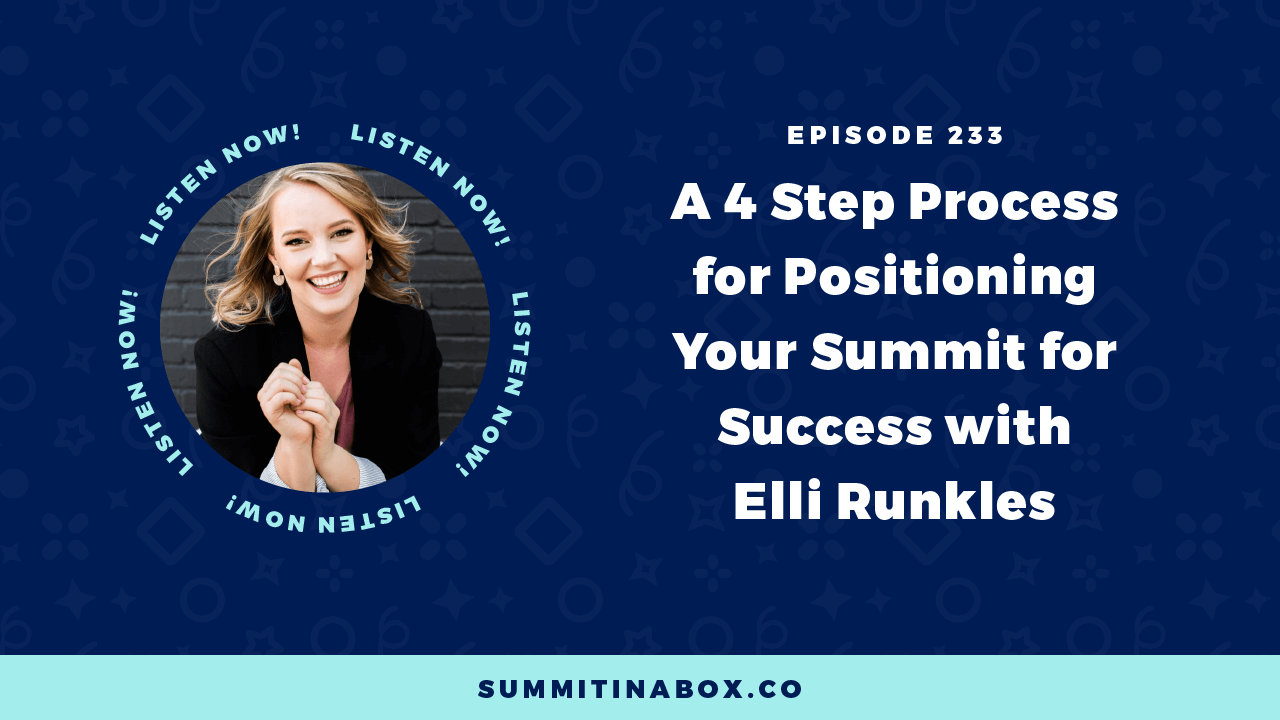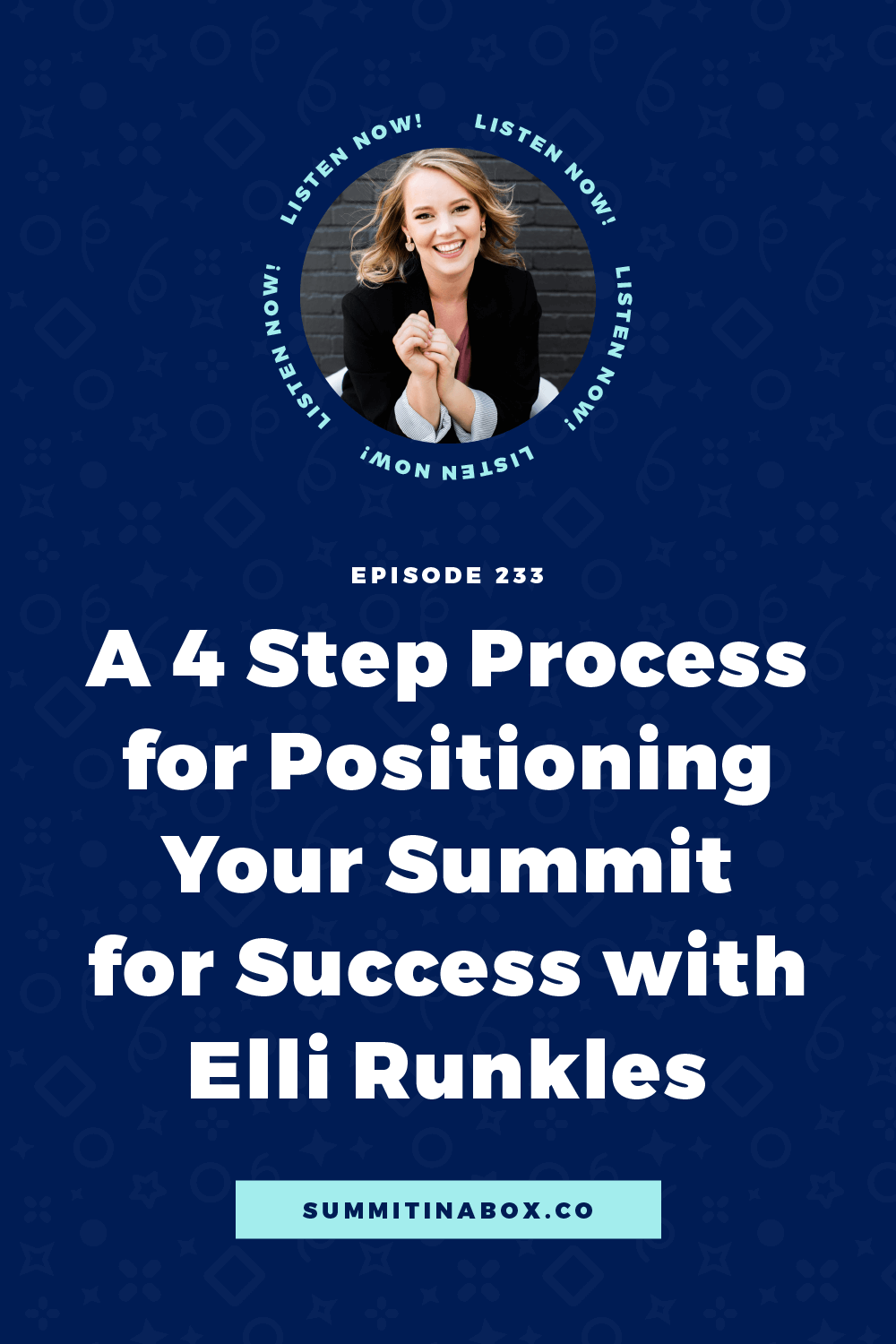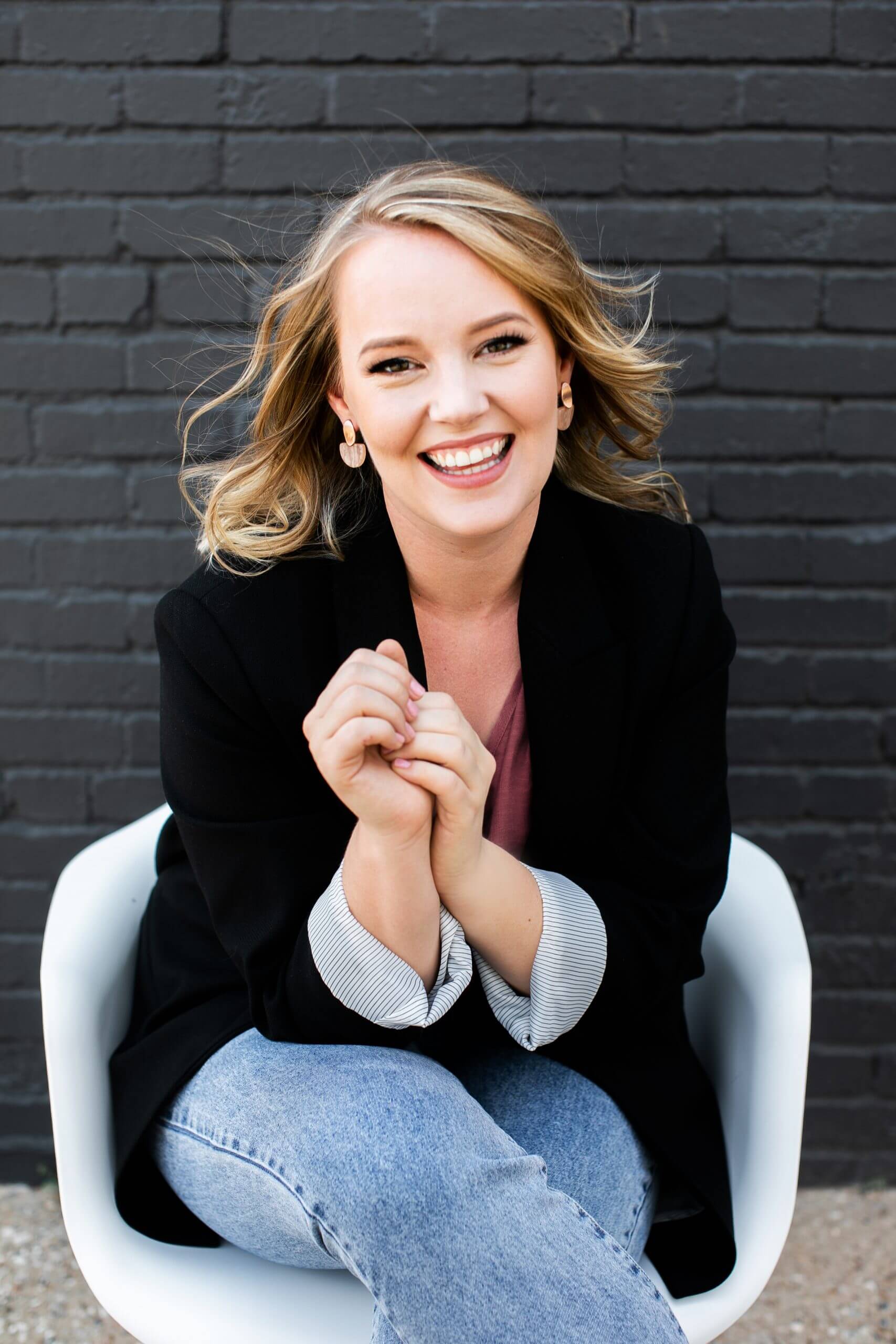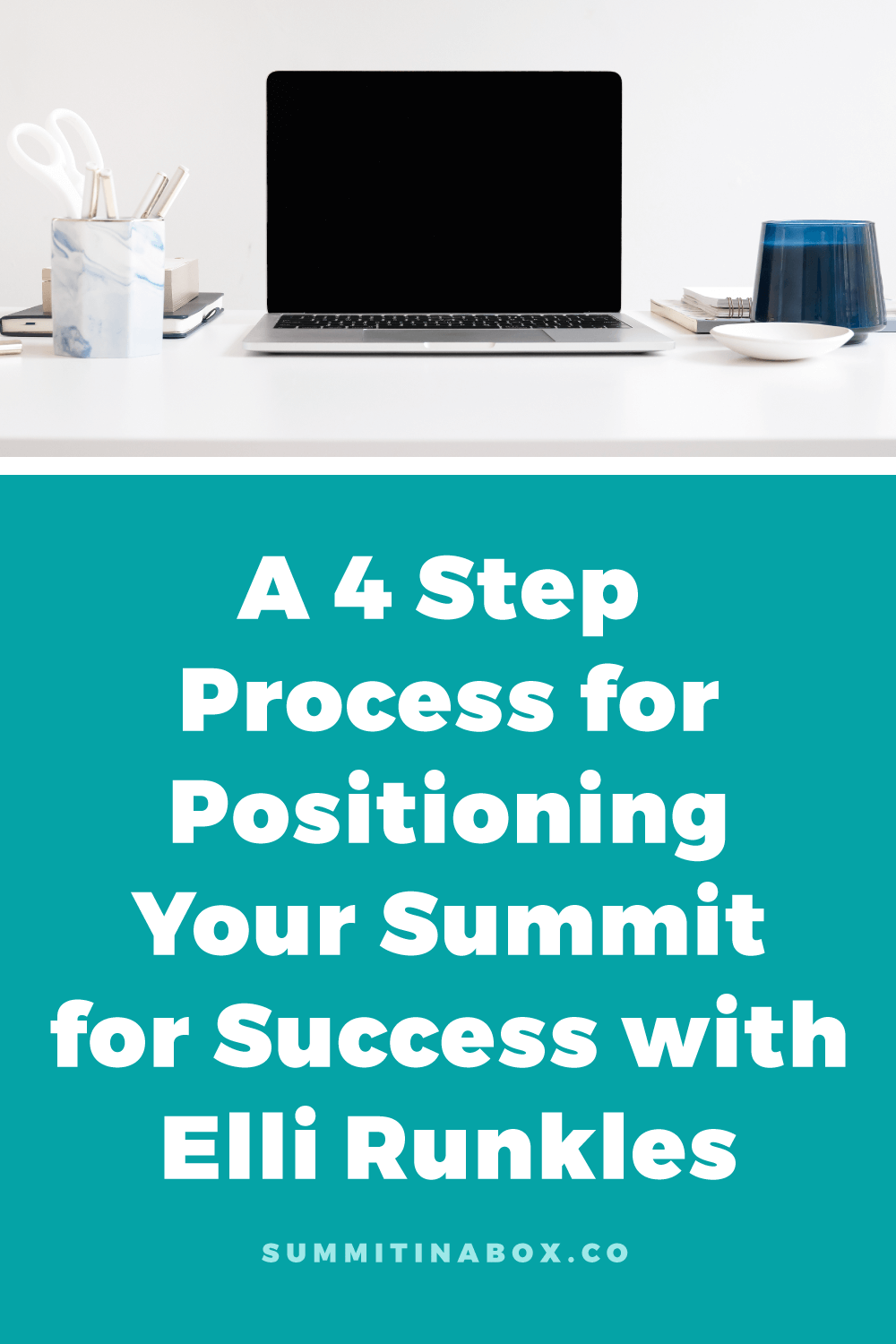A 4 Step Process for Positioning Your Summit for Success with Elli Runkles


This week, I’ve got a very special guest with me today, Elli Runkles, who happens to be our marketing co-lead and Client Success Coach here at Summit in a Box! Elli is an overall genius when it comes to all things related to summit positioning, messaging, and copy. She also helps with the process of turning our podcast episodes into blog posts and noticed just how often I reference episodes 4 and 5 of this podcast when talking about summit positioning. Those two episodes are about choosing your summit audience and choosing a profitable summit topic. Buuut they came out in August of 2019, and a lot has changed since then! 😬
It’s time for an updated take on how to position your summit for profit and high conversion rates, and Elli is joining me on the podcast today to talk about the process she goes through with our clients to help them position their summits for success.
The truth about summits is that positioning plays a huge role in the results you end up with. Everything else about the event can be planned absolutely perfectly but if your positioning is off, it’s going to be a flop.
On the flip side, though, you could have no audience, skip the bells and whistles, and host a summit that blows your goals and expectations out of the water - if you get the positioning right.
I honestly cannot stress the importance of positioning enough, but to make this episode fun, instead of listening to me talk through things, I'm going to interview Elli.
We're going to talk about:
- Why your summit positioning is the #1 most important decision you'll make about your summit.
- The biggest mistakes related to positioning that Elli sees our clients make in the early stages of their planning process and how she helps them through it.
- A step-by-step process for figuring out the best positioning for your summit that you can follow on your own.
Listen to the episode
Elli’s Background: From Copy to Positioning
Before we start, let’s hear Elli’s background on how she came to be a positioning expert.
Before joining the Summit in a Box team, Elli had an online business offering conversion copywriting services and coaching. Through working with clients in that business, she found that many of her clients were struggling to answer some of the core questions about their offers and target audience which were crucial first steps to being able to write copy.
These questions included things like:
- How does your offer help people specifically?
- What outcomes is it going to help them create?
- What's the transformation that you're taking people through?
- How does it compare to other alternatives out there?
- What makes your offer different or better for your target audience?
These are all positioning questions, and before moving forward with writing copy about an offer, you really need to be able to answer them. You don't need to be able to say it in a polished "copywriter's voice" but you do need to know these answers for yourself before successfully selling or promoting an offer - whether it's a summit, a course, a service, or anything else.
As Elli started seeing more and more clients need help with answering these positioning questions, she naturally started shifting into coaching her clients on positioning in order to help them find clarity on these details about their offers.
This type of positioning work is an important first step for anything you're promoting or selling, and Elli's experience doing positioning coaching for clients on their courses, services, and other offers has translated so well into coaching on summit positioning!
We’ve been able to uplevel our students’ and clients’ results and see first-hand the difference it can make when you have high-level positioning support for your summit.
Why Summit Positioning Is So Important
Solid positioning is the foundation for success with anything you're putting out there in your business, including a summit. You need to have clarity on the core details of what you’re creating, who you’re creating it for, why you’re creating it, and how it helps them in order to effectively promote a summit and draw in the right audience and help them understand how your event will benefit.
As the online business and virtual summit spaces grow and become more crowded, you need to know how what you are doing compares to what everyone else is doing, in order to demonstrate how your event is different and can stand out. When you get your positioning right, it makes all the other pieces of planning your summit fall into place so much easier.
Many people think of summit positioning as simply the audience, topic, name, and tagline for your event., but your positioning really has a knock-on effect and impacts everything.
For example, your summit positioning plays into:
- Pitching speakers – When you’re positioning is clear, your potential speakers will know right off the bat who this summit audience is and how it’s going to help that audience. They’ll know right away if that's an audience they want to be in front of, and if their expertise and messaging are aligned with the event. It makes it an easy 'yes' for the right speakers.
- Speaker promotion – Your speakers are more likely to promote the event when it's positioned well because it’s been clearly communicated how it’s going to help their audience. They will want to get their audience to that summit, and they'll feel confident promoting it knowing that it's something that's truly of value for them.
- Promotion – The perfect-fit attendees are more likely to sign up when the positioning is right because they can tell right away that the summit is for them, and they understand how they're going to benefit from attending.
- Conversion rates – As a general rule, when your positioning is right, your conversion rates will typically go up across the board. When a summit is positioned well, that increases the conversion rates of your registration page, leading to more total attendees seeing the all-access pass. That alone would increase sales, but typically good positioning creates more "buy-in" from attendees, which leads to a higher all-access pass conversion rate in addition to more people seeing the offer. It really compounds!
- Attendee experience – Planning an impactful attendee experience also becomes easier when you get your positioning right. Throughout the planning process, you’re able to intentionally design the event experience based on the transformation you want to create.
All of that compounds together and leads to an exciting and impactful event for everyone involved, which translates into more raving fans because they had an amazing experience, more connections and opportunities for collaboration with your speakers in the future, and more post-summit sales.
The Biggest Positioning Mistake
The biggest mistake we see with summit positioning is going too broad and not having a specific enough audience or topic. The second is using vague language that’s unclear on what the event is about and who it’s for. If the messaging is vague, it doesn't matter if your audience, topic, and transformation are specific, because it's not being clearly communicated.
Something that comes up often with our clients is that they try to fit too many ideas into their summit positioning because they’re trying to serve too many people or share too much information through their event.
We know this is coming from a really good place of having a ton of knowledge that they want to share with as many people who need it as possible, but, in the end, it ends up having the opposite effect. The lack of clarity on what who it's for and what the attendees will learn at the event ends up making it harder for people to say yes to.
Elli works with clients on this often in order to help them refine the core pieces that they really want to focus on through their event that will have the most impact.
How to Determine Your Positioning
It's like that saying: you can't see the forest for the trees. For clients, when they're in the thick of working with and helping their people, it's really hard to sort through which of these things people need to know right up front in the promotion to be really drawn in versus what are things that come later.
For many of our clients who are struggling with their positioning, they are so close to their area of expertise, that it can be hard for them to sort through what information people need right up front during promotion, and what needs to be communicated later - whether that's in their post-registration sequence, or during the event itself.
When it comes to figuring those things out, Elli always comes back to two things in her positioning coaching:
- What are the client’s goals? Why they’re hosting the summit and what they’re hoping to get out of the summit?
- Who is their audience? What do their people really need to know about this topic?
For our Launch with a Summit Accelerator clients, when they are coming into the process of hosting a summit, they're not just thinking about it as a one-time project or cash injection. It's a strategic business decision that's almost always rooted in selling something else like a course or membership that is going to be aligned, but different, from the summit.
Also, people have goals around the impact they can have with a summit and goals connected to other things that are more personal that they want to make sure to incorporate into the summit, too.
So, I always want to come back to those reasons of why they’re hosting a summit.
A lot of the positioning decisions will end up getting tied back into what they're launching after the summit: the course, membership, or group program. We need to kind of step back and see what the end goal is and work backward from there to see if the information we’re giving them through the summit makes sense.
Elli asks a lot of questions, and she knows that it can feel like a bit of a tedious process to go back and forth with all the different pieces that need to be considered, but we’re always able to get there and land on summit positioning that the client feels really good about after going through the process.
The Steps to Positioning Your Summit Right
If you're going through the process on your own, follow these steps to land on the positioning that leads to a profitable and high-converting summit that people want to be a part of, whether it’s wanting to speak, sponsor, or attend:
Step 1: Know your end goal
We touched on this a little bit, but starting with the end in mind is where Elli always encourages people to start. Know what your end goal is, whether that’s selling a course or membership, or something else. You also want to keep in mind the end goal in terms of the impact you want to have or the transformation you want your attendees to experience.
That's where we want to start so we know what we're leading up to.
Step 2: Narrow down your audience
From there, what we look at next is the audience. Typically, the audience for the summit is going to need to be narrowed down more than the audience for the end offer. That's not always the case, but it often is. We look at the audience first and look for ways to narrow that into a subgroup of who your wider offers serve.
How to Know If You Need to Narrow Down Your Audience
As an example, at Summit in a Box, we serve a wider audience. Our last summit was for course creators, but our offers of Summit in a Box and the Launch with a Summit Accelerator are for a wider audience than just course creators. But to stand out in the online business space, we need to narrow that down into one subgroup of the wider audience. Going just a little bit narrower helps make it stand out just a little bit more and creates a curated event for a specific group, rather than “this is for anybody”.
Another thing that may help is if you try to brainstorm problems your audience has or outcomes they can get from the summit. If you find that your answers to these questions are pretty general or could apply to lots of different groups, that’s a big clue that you need to niche down a bit more.
You probably need to narrow down your positioning more if you’re using language like “finding meaning”, “finding purpose”, or “stop feeling overwhelmed”. These are things that could apply to endless different groups, and you need to be able to speak to the specifics of what these experiences look and feel like for the particular group of people who your summit is for. Getting more specific helps to make the audience feel seen and understood, and that your summit isn’t just general information they’ve seen before but is something uniquely for them.
Step 3: Create an experience
This next one is kind of in the middle between choosing the audience and choosing the topic, but I really like to spend some time honing in on the experience that they're wanting to create during the positioning process. It's important to have a clear understanding of the transformation or experience you're trying to create for your attendees in order for them to be ready for the offer at the end.
A good question to ask yourself before choosing your summit topic is: What's point A where your attendees are before your summit, and what's point B that we're trying to get people from to be ready for the course?
Check out this episode on how to use learning design to increase the impact of your virtual summit for more.
Step 4: Choose your profitable topic
Once we have the attendee experience mapped out, we're ready to choose the topic. I've touched on this already, but the summit topic can be a pretty nuanced decision, especially when it comes to launching with a summit because we need to make sure that it's going to naturally lead into the course.
We don't want to have a summit topic that's 10 steps ahead then what their course is going to help with, because then at the end of the summit, they're not going to be ready for the offer. But at the same time, we don't want to overpower the offer that is going to be presented by covering the things that are covered in the course during the summit, so that's kind of a balancing act.
Case Study: Our Process of Going Through the 4 Steps for Our Last Summit
Let's look at the process we went through when following these 4 steps to determine our positioning for our last summit at Summit in a Box. We hope this example helps you to better understand how we think about and approach summit positioning!
Step 1: Know your end goal
The end goal for us, from a business perspective, was to sell the Launch with a Summit Accelerator, which we knew we'd be pitching at the end of the summit. From the attendee perspective, the end goal was to get them to a point where they understood the benefits of hosting a summit, how a summit would help them reach their business goals, and what the process looks like so they’re ready to make plans to move forward with hosting a summit.
What if you’re not launching anything at the end? If you’re not selling anything at the end, think about what other end goal you have for your summit. What are you wanting to do with these new leads that come through the summit when it’s done? Maybe you want list growth for a course you’re going to sell down the road. Maybe you have a service you want to sell. You want to think about what you’re going to do with those leads once you have them on your list before choosing your summit positioning.
Step 2: Narrow down your audience
When we think about launching the Accelerator, our ideal attendee has some scalable offer they want to sell through the summit. For us, that’s course creators, membership site owners, or people selling a group coaching program.
Those three stand out to us and are the easiest category to put people into. So for our last summit, we looked at those subgroups and picked one to focus on for the next summit. Although course creator is still a very broad audience, we went into it knowing we wouldn’t have super high conversion rates, but all things considered, we decided this was the best audience for us to focus on, based on our end goal.
Sometimes our Accelerator clients end up with a little broader audience because of the other goals they have for their summit beyond revenue. So, it can make sense to be a little broad sometimes, but you have to know going into that your conversion rates might be a little lower because of it.
Step 3: Create an experience
For our last summit, the experience we wanted to create for our attendees was that they’d walk away in a position where they felt confident with their course launch and ready to move forward with their summit.
We positioned our summit not just for course creators, but we really tried to speak to people who had existing courses they were already selling, not new course creators launching their first course.
Our speaker sessions and topics were speaking to people who had already launched something that was working and helping them build on what they already had.
Step 4: Choose your profitable topic
When we went into planning this edition of Sell with a Summit, the topic was already pretty established. But in terms of the more nuanced details of what topics we wanted covered and how we presented the information, we narrowed it down to how to make more course sales of something that’s already working and make it better.
We had sessions focused on refinements you could make to your course launch strategies and how those refinements would help your post-summit launch.
Next Steps for Choosing Your Summit Positioning:
If you've been following along and thinking about your summit positioning, but you're still not sure you have the exact answer right this second, don't worry. That’s normal and to be expected. Summit positioning isn't a quick and easy decision to make.
In some cases, if you’re business is already in a smaller niche and your overall positioning is very clear and specific, you might be able to nail down your summit positioning pretty quickly.
But for a lot of people who are going into the summit hosting process, it can take some time to get it right. In the long run, it's so worth it to take the time to do this in the beginning, because it's ultimately going to save you time and make the time that you put in so much more worth it. When you take the time to go through this process in the beginning, you're setting yourself up for success.
If you’re stuck on your summit positioning, or you know you want to host a summit but don't know what the topic should be, know that this is a very common concern, but we’ve never had anybody that couldn’t figure it out.
If you stick with it, you will get to the end result. Sometimes it takes longer than others, but it’s doable and it's worth taking the time to figure that out.
We'd also love to support you in that process of figuring out your positioning so you can feel confident moving forward with your summit knowing that you're set up for success! If you have a proven offer, course, membership, or group program and you want help with this (and literally every step of the process!), we would love to have you apply to join us in the Accelerator.
If you're ready to host a high-converting virtual summit to replace your slow-growth marketing strategies and use it to lead into your biggest course launch yet, I've got an exclusive training just for you. This training will show you how to host a summit that blows industry standards out of the water, seamlessly leads into your biggest course launch yet, and sets you up for additional post-summit profits on the back end. Inside the Accelerator, we help our clients consistently host life and business-changing virtual summits, and in the free private training, I'll show you exactly how it works along with all kinds of examples. So apply for an invite to the Launch with a Summit Accelerator and get the training.
About Elli
 Elli Runkles is a copywriter and messaging strategist who’s been writing empathy-filled conversion copy for 6 and 7-figure personal brands since 2018. In 2022, she joined the Summit in a Box team as Marketing Co-Lead and Client Success Coach in the Launch with a Summit Accelerator where she provides strategic insights, copy revisions, and coaching to help our clients host wildly successful, high-converting virtual summits. Elli is a digital nomad who’s lived abroad for over a decade, currently residing in Portugal.
Elli Runkles is a copywriter and messaging strategist who’s been writing empathy-filled conversion copy for 6 and 7-figure personal brands since 2018. In 2022, she joined the Summit in a Box team as Marketing Co-Lead and Client Success Coach in the Launch with a Summit Accelerator where she provides strategic insights, copy revisions, and coaching to help our clients host wildly successful, high-converting virtual summits. Elli is a digital nomad who’s lived abroad for over a decade, currently residing in Portugal.
Website | Connect on Instagram
Resources
- Summit Host Hangout: Summit to Launch Episodes
- Episode 4: Discover Your Ideal Virtual Summit Audience
- Episode 5: Choose a Profitable Virtual Summit Topic
- Episode 81: How to Use Learning Design to Increase the Impact of Your Virtual Summit with Emily Walker
- Episode 84: Create Raving Fans & Dream Customers Through a Virtual Summit with Desola Davis
- Episode 158: How to Make Non-Transactional, Ick-Free Speaker Connections with Michelle Warner
- Episode 215: Expand Your Body of Work and Increase Your Impact with a Virtual Summit
- Episode 228: The Power of Repeat Summits (and how they're not a 1-time cash injection)
- Summit Host Hangout Facebook group
- Launch with a Summit Accelerator
- 6-Figure Summits Workshop Bundle
Pin it for later!




